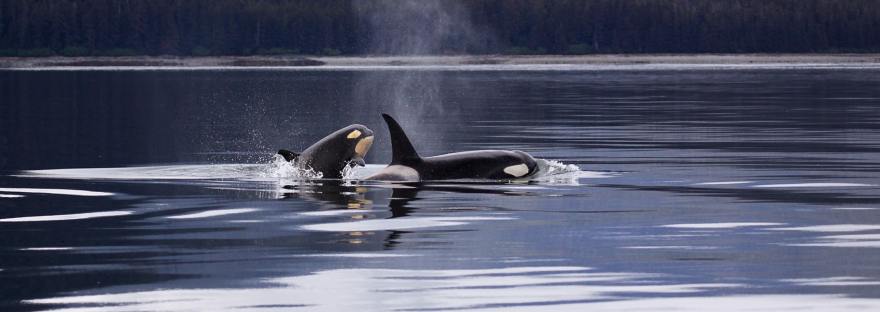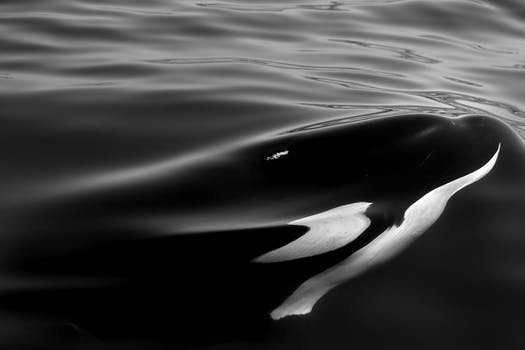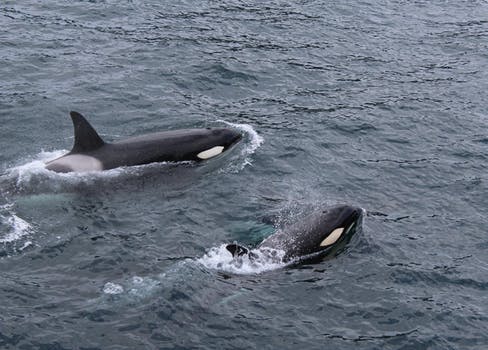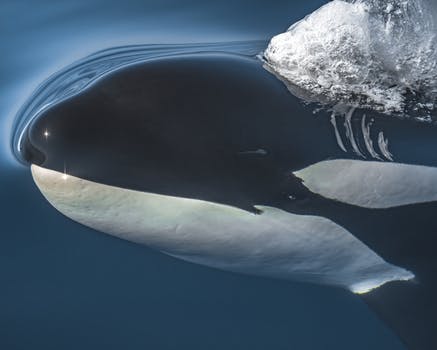I am thrilled to be sharing this guest post from fellow wildlife blogger, Kayleigh. She is currently working on a blog series sharing the sad stories of individual orcas in captivity. Read on to discover more about one of the UK’s stunning marine creatures.
Immense, intelligent, magnificent black and white monarchs of the sea, orcas are perfectly adapted to life in the open ocean and are one of nature’s top apex predators. They are the largest species of dolphin, which are, just to confuse things, all classed as toothed whales. Another name for orca is killer whale, which is thought to have originally been “whale killer”, as they are the only marine mammal to hunt other whales.
Orcas are the most widely distributed of all cetaceans, and are found in every ocean. Several distinct eco-types are known, each occupying different regions and displaying unique behaviours, though they are all morphologically similar.
Orcas can swim incredibly fast and have been recorded at speeds of up to 34 miles an hour! They also travel widely and are capable of covering hundreds of kilometres in a day. In the wild, orcas are extremely long-lived and females have been known to surpass 90 years of age!
Orcas live in close knit communities made up of family groups, each with their own distinct vocalisations and cultures. The orca pod is a matriarchal society, which means that a female is the centre of the killer whale world. Bonds are extremely tight between pod members and last for a lifetime.
Calves stay with or near their mothers throughout their lives, and whilst female offspring may break off to start their own pods, they usually stay near their mother’s pod, and will often join up to form what is known as a clan. Sometimes a single pod can contain four generations, and can number up to 50 individuals.
Within these family groups, all adult whales take part in raising the calves. Other orcas within the pod will babysit youngsters, which helps take the pressure off the mother, strengthens the bond between the orcas and allows for the passage of knowledge and culture throughout the generations. Pod members of both sexes teach the youngsters essential skills such as hunting techniques, social interaction, knowledge of feeding and breeding grounds and migration routes.
Orcas eat a variety of food, and different pods often have particular feeding preferences. For example, some orcas consume only fish, whereas others specialise on marine mammals, such as seals.
Interestingly, mammal-eating orcas live in smaller pods and hunt silently so as not to alert their prey to their presence. In comparison, fish-eating orcas live in much larger pods and communicate constantly as fish cannot hear their echolocations.
Orcas have a global distribution, however the most studied orcas in the world are the resident orca pods off the west coast of Canada and the USA. These resident pods are so named because they stay in inland or nearby coastal waters.
There are two sub-groups of residents, known as northern and southern residents based on their home territories. These two groups are separate from each other and tend not to overlap. Both populations are clans made up of several pods that are all related matrilines.
In comparison to the residents, transient orcas range over wider areas and further out into the open sea. Their pods are still made up of matrilines, however they tend to have fewer individuals. This could be due to the fact that their prey consists entirely of mammals, who would be alerted by a large group. Transients and residents are distinct genetically and are not thought to interbreed. They also do not share any calls or vocalisations, proving them to be unique populations.
Happily, it is possible to see orcas around the British Isles! There is a small pod in the Hebrides known as the West Coast Community, which is the only resident pod of orcas in the UK. Sadly this pod now only numbers eight individuals, four males and four females, and the population is under threat due to high levels of contaminants in the ocean.
The individual whales can be identified by the size, shape and marks on their dorsal fins as well as other distinguishing markings. Amazingly, two orcas from this population were recently spotted off the coast of Cornwall, demonstrating just how far these incredible beings can travel.
There is also a fairly large community of orcas around Orkney and Shetland, and it is thought they belong to a population that also ventures to Iceland. The Icelandic Orca Project researches and monitors the orcas that are seen around Iceland in order to aid their conservation and protection, and photo ID is being used as a tool to compare individuals seen in both Icelandic and Scottish waters.
Sadly, orcas have suffered, and continue to suffer, from exploitation at the hands of humans. The first orca to be captured and kept in captivity was a female called Wanda in 1961, and it has continued to happen since then. It is extremely cruel to take wild animals such as orcas from their natural habitat and confine them to the deafening silence of a concrete tank.
Being separated from their families and plunged into an alien environment is a horrific thing for any animal to endure. Performing silly tricks in shows adds insult to injury. It is demeaning and degrading and teaches people nothing about their lives in the wild. Captivity is detrimental to the whales’ mental and physical wellbeing.
I campaign for the freedom of all captive marine mammals, whether back into the wild or into appropriate sea sanctuaries. I am currently in the process of writing about each orca who remains in captivity, to raise awareness of their plight. See them all by visiting my website here. Follow Against Captivity on Facebook for more information on the fight to end captivity and how you can help.
If you enjoyed this blog, you might also like:






I didn’t know that orcas could be either carnivorous versus pescetarian!
LikeLiked by 1 person
No me either!
LikeLiked by 1 person
Good work campaigning for the quality of life of these magnificent creatures.
LikeLiked by 1 person